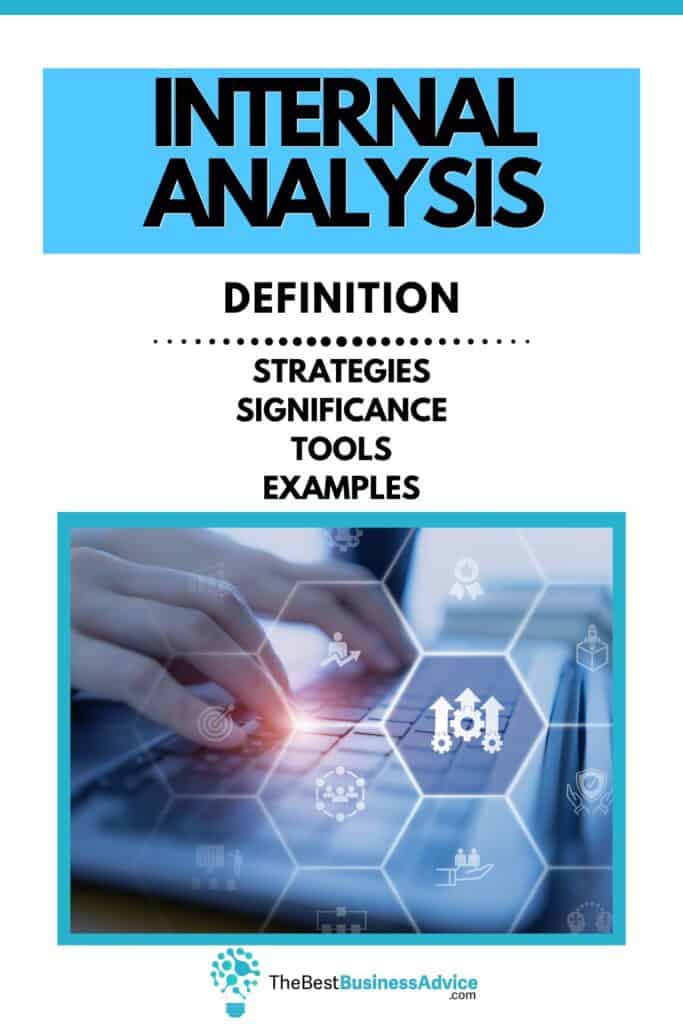Internal Analysis: Definition Strategies, Significance, Tools, And Examples
To be successful in business, firms must have an objective understanding of their capacities, systems, strengths, and weaknesses. Evaluating their inner organizational dynamics enables companies to formulate effective market strategies. This vital self-reflection is called internal analysis.
Internal analysis is the identification, classification, and evaluation of endogenous organizational variables to improve a firm’s performance and profitability. By critically examining their financial resources, operational systems, and expertise, firms can maximize their competitive advantages.
Analyzing endogenous organizational variables is vital for a company’s competitiveness, sustainability, and profitability. For anyone wishing to know more about internal analysis, here is a detailed explanation of this complex analytical process.

Internal Analysis Definition
Internal Analysis is a process undertaken by organizations as part of their strategic research and planning activities.
This mode of inquiry systematically identifies, classifies, and evaluates the endogenous resources and capabilities of organizations or businesses. Conclusions from the internal analysis process inform and guide the organization’s strategic planning and management.
Internal analysis focuses on factors within the organization’s sphere of control or influence. The organizational factors that receive scrutiny include production, marketing, finances, labor, knowledge, and skills.
This rigorous investigation highlights the strengths and weaknesses of a business’s internal systems. The principal aim is to reveal the resources and activities that give the enterprise a competitive advantage.
These insights enable organizations to maximize their operational efficiencies and concentrate on the business activities with the most revenue-generating potential.
Internal Environment Analysis
There are two common ways of defining internal environment analysis.
In the first definition, international environment analysis is the inquiry into endogenous organization resources, structures, and processes. People often use this definition when discussing internal analysis (without the environment in the title).
The second way of defining internal environment analysis goes slightly beyond the organization’s boundaries to include exogenous factors.
This broader conception of the internal environment encompasses proximate economic, political, and social actors and forces surrounding an organization. These external factors affect the firm’s commercial activities and prospects. The organization is also partially able to influence the exogenous actors and forces.

5 Strategies In Analyzing Internal Environment
There are multiple strategies for analyzing an organization’s internal environment.
Resource-Based Strategy
The resource-based strategy for internal environment analysis focuses on a firm’s resources. This strategy helps firms determine their competitive advantages, and develop operational and marketing strategies that capitalize on those strengths.
When managers and consultants implement a resource-based analytical strategy, they investigate the quality, abundance, and strategic value of three categories of resources:
- physical (e.g., land and manufacturing equipment),
- human (e.g., expertise and company culture)
- organizational capabilities (e.g., branding and operational systems).
The resource-based approach to internal environment analysis enables firms to identify and exploit resources that are:
- valuable,
- rare,
- expensive or impossible to replicate.
The process for conducting resource-based analysis is presented below.
Analysis Of Resources
The first phase of the process is to analyze the organization’s resources.
This phase involves the identification and categorization of the various resources that the firm can access and deploy.
After collation and assessment, the analysis formulates the most optimal ways to use the resources derive maximum strategic benefit from them.
Finally, the analysis considers crucial factors like how transferable the resources are between the various units of the organization. The inquiry also determines the sustainability of the company’s physical, human, and organizational resources.
Analysis Of Capabilities
The second phase of the resource-based strategy identifies and classifies the capabilities of a firm. These capacities refer to intangible human and organizational resources.
The resource-based strategy identifies and classifies the following capabilities of firms:
- operational and management systems,
- knowledge,
- skills,
- workplace culture,
- intellectual property (e.g., branding and trademarks).
The capacities are evaluated according to their contribution to operational and strategic goals. The analysis also reveals ways to increase the efficiency of those capabilities.
At this point in the analysis, the resources for each internal capability are mapped clearly. Identifying these linkages provides an objective view of the inputs that sustain the most strategically significant human and organizational capacities.
Analysis Of Competitive Advantage
The third phase of resource-based internal analysis seeks to determine the competitive advantages that the firm can derive from its internal capacities.
This phase integrates the investigation of the resources and capabilities available to the organization. The aim is to find potential synergies between these internal capacities that give the firm an advantage against its competitors.
Having identified its competitive advantages, the firm is well-positioned to develop optimal organizational and market strategies.
2. Performance Strategy
The performance strategy for internal environment analysis often accompanies the resource-based approach.
One of the most widely used and reliable methods for analyzing performance in a company is called the ‘performance impact of market strategy (PIMS)’.
The PIMS strategy evaluates the performance of operational, management, and marketing activities by analyzing their contribution to the aims and objectives of the organization.
The purpose is to ascertain how each activity advances or undermines a company’s financial status and long-term viability. PIMS analysis also determines the conditions that facilitate the positive effects of these internal variables.
PIMS analysis determines how internal activities impact the financial dimensions of a company, such as:
- profitability,
- sales volumes,
- investment levels.
The analytical strategy also investigates the effects of internal activities on the firm’s competitiveness and long-term viability. This component of the strategy examines the impact of the firms’ operations, marketing, and management activities on a range of non-financial indicators, including:
- value of products,
- labor productivity,
- position in the market.
The findings of PIMS analysis inform the development and review of a firm’s market strategies.
3. Value Chain Strategy
Analyzing value chains is another well-established strategy for strategically examining an organization’s internal environment.
This strategy investigates the sequential linkages between the firm’s internal systems, processes, and activities.
The analysis focuses on value chains for individual products and services. Each value chain has a series of primary activities, for instance:
- incoming logistics,
- operations,
- outgoing logistics,
- sales and marketing.
The strategy also examines the supporting elements in every phase of the value chain. These elements include:
- procurement,
- technologies (plant and equipment),
- human resources,
- organizational infrastructure.
This analytical strategy aims to find the points in a firm’s internal value chains that generate the highest value for the organization or contribute to its competitive advantage.
4. Functional Strategy
Functional analysis is a straightforward but effective strategy that critically assesses a firm’s internal functions and their contribution to the enterprise’s goals.
The first step in functional analysis involves identifying the organization’s core functions. These functions vary depending on the business but generally include:
- financing,
- research and development,
- production,
- marketing
- human resource management,
- general management.
The second step in the functional strategy involves a detailed investigation of the inputs, expertise, strengths, and weaknesses associated with each organizational function.
In the case of financing, for instance, the functional approach analyzes where the firm’s funding derives from, how funds get invested, and the way profits are utilized.
The concluding step in this analytical strategy evaluates how the various functions affect:
- operational efficiency,
- sales,
- profitability,
- brand reputation.
With the functional strategy, firms can confirm which functions produce the most beneficial impact on an organization’s commercial success and long-term sustainability.
5. Internal Factors Strategy
Internal factor analysis is a strategy for critically investigating the endogenous variables that give firms their gain competitive advantages.
This strategy is analogous to other internal analysis approaches. The difference is that internal factors analysis restricts its focus to a few factors essential to the firm’s success. Other strategies for internal analysis typically include the full range of advantageous factors.
Another aspect that distinguishes internal factor analysis from most alternative strategies is the inclusion of external actors.
Internal factor analysis reveals the levels of cooperation and antagonism that exist between a firm and the external actors it transacts with, such as:
- competing firms,
- suppliers,
- brokers,
- customers,
- lobby groups.
There are four methods for implementing internal factor analysis:
- examine the lifecycle stage of products and markets,
- compare firm with competing companies,
- compare previous and current resources and capabilities,
- compare operational performance with industry standards.
The strategy leads to the elevation of the most unique or otherwise strategically invaluable internal factors and marks these for prioritization when allocating the firm’s resources and capabilities.
Why Is Internal Environment Analysis Important?

Internal environment analysis is a vital requirement for organizational success. Firms need a comprehensive and detailed view of their inner dynamics if they hope to develop strategic plans that advance the firm’s aims.
Internal environment analysis gives organizations the knowledge they need to achieve their goals. Without the knowledge generated by internal environment analysis, organizations are operating blindly.
Through internal environment analysis, a firm gains an objective understanding of its resources and organizational capabilities. The analysis enables companies to evaluate the strengths and weaknesses of their various elements and how they relate to market competitors and conditions.
By evaluating the internal elements of the firm, the company knows how specific structures, processes, resources, and activities contribute to its economic performance. In this way, internal environment analysis clarifies the strategic significance of the company’s endogenous variables.
Having analyzed the significance of the components in the internal environment, firms can identify and capitalize on their competitive advantages.
Based on the findings from internal environment analysis, organizations can engage in effective strategic planning. The results provide the intellectual foundation for firms to devise strategies that harness their competitive advantages and strengthen their market positions.
What Tools Are Used In Analyzing Internal Environment
The strategies for internal environment analysis are implemented using a diverse range of tools. In the digital era, the process typically involves sophisticated data analysis software. These programs offer a powerful and efficient way of examining an organization’s internal environment and optimizing strategic decision-making.
Data analysis software enables firms to rapidly process vast amounts of disparate information. The tools provide firms with a holistic perspective on their internal environment and the interrelations between its multiple elements.
Most data analysis software focuses on quantitative information about the firms’ operations and resources.
There are also, however, software programs for analyzing qualitative data. These programs organize, categorize, evaluate, and model information that is not conducive to measurement. The tools facilitate the analysis of internal factors such as human resources, organizational culture, communication, and product quality.
There is a diverse array of software programs dedicated to performing specific analytical tasks. Here are some highly rated software programs and their specialized applications in internal environment analysis:
- Posit – statistical analysis
- erwin Data Modeler – data modeling,
- MAXQDA – qualitative data analysis
- IBM SPSS – predictive analysis,
- Highcharts – data visualization.
These software tools give businesses unprecedented analytical capabilities. The programs create opportunities for firms to optimize their operational systems and enhance their strategic planning in ways that were not possible in previous decades.

Real Life Examples of Internal Environment Analysis
To illustrate what internal environment analysis looks like in real life, here are some examples of this analytical process applied to Starbucks using two strategies.
SWOT Analysis of Starbucks
Starbucks is an internationally-recognized brand with company operations around the globe. The company’s competitive advantages stem from its ability to offer high-quality beverages and convenience food items at premium service.
Applying the common strategy of SWOT analysis (strengths, weaknesses, opportunities, threats) to Starbucks’ internal environment reveals the reasons for the enterprise’s success. The analysis also highlights the potential challenges that might confront Starbucks.
| SWOT Analysis of Starbucks | |
| Strengths:robust market position with well-established brand recognition and loyalty (over 35% of US market share),high-quality products and services,stores are strategically located and visually pleasing,effective human resource management fosters motivation and optimizes performance among employees. | Weaknesses:costly products (due to their quality),saturation of core markets due to scale and pace of expansion (more than 8000 stores in the US alone),negative perceptions of the brand associated with public animosities towards global corporate enterprise,imposition of US coffee culture undermines the company’s brand reputation in some countries. |
| Opportunities:expanding into new markets, primarily in developing countries using the company’s global resources and capabilities,growth of retail activities by expanding partnerships with mass retail companies,technological developments like mobile apps offer opportunities for increasing operational efficiency and building customer loyalty. | Threats:growing competition in mature coffee markets (like the US) is the most significant threat facing the company,instability and unpredictability of global coffee supplies. |
Value-Chain Analysis Of Starbucks
In this example, Starbucks’ internal environment is examined using value-chain analysis. Using this strategy, one can assess the company’s primary and supporting activities and evaluate their contribution to the firm’s competitiveness and profitability.
Inbound logistics
Starbucks sources unique, high-quality coffee beans from a variety of local producers around the world.
The company has established strong and mutually-beneficial working relationships with its producers. This element of the internal environment facilitates access to a reliable, cost-efficient supply of premium coffee.
Starbucks’ links with coffee producers are crucial for sustaining the company’s extensive global supply chains. These integrated supply chains are highly efficient, providing Starbucks with a significant competitive advantage in the market.
Operations
The nature and scale of Starbucks’ operations are other critical points of competitive advantage. With operational units in 60 countries, the company can significantly increase operational efficiencies and reduce costs through economies of scale.
Combining company-owned stores with licensed retail units is another of Starbucks’ internal strengths. This dual operational strategy allows the company to expand its operations and revenue-generating opportunities without the need to manage or invest in additional stores.
Outbound Logistics
Starbucks distributes its product range through its owned and licensed retail outlets. This approach facilitates organizational efficiencies and synergies as products move through an integrated supply-chain network.
The firm also distributes its beverage and snack products to mass retail companies.
Starbucks gains a competitive advantage by offering multiple convenient payment systems in its stores, including mobile payments and prepaid Starbucks customer cards.
Marketing And Sales
Starbucks does not focus as much resources and effort on marketing to generate sales relative to many of its competitors.
The company’s positive brand recognition and customer loyalty derive from its quality products, services, and consumer experience. This approach minimizes the need for Starbucks to invest excessive amounts of capital in formulating and implementing sophisticated marketing strategies.
Infrastructure
Starbucks stores are neat and attractive, with professional, high-quality designs, materials, and finishes. The aesthetics of the company’s retail units give the company a considerable competitive advantage.
Starbucks’ efficient and globally-integrated legal, accounting, and finance divisions are crucial roles managing the firm’s infrastructure.
Technological Innovation
Starbucks obtains organizational benefits through fostering technological development across its various value chains.
The creation and introduction of the Starbucks mobile app is a prime example of technological innovation producing additional value and competitive advantages. The app has attracted new customers ad reinforced brand loyalty among existing consumers while lowering operating and marketing costs.
Human Resources
Human resource management is another crucial supporting element in Starbucks’ value chains.
The company’s philosophy, systems, and processes for human resource management are conducive to fostering a motivated and productive workforce. Starbucks provides fair compensation and benefits, and a supportive work culture, which encourages employees to optimize the performance of their tasks.
Procurement
As noted earlier, Starbucks has efficient supply chains and positive relationships with suppliers. These organizational systems and relationships enable the company to procure premium inputs at competitive prices.
Wrap Up
Internal analysis is an essential element of strategic planning processes. By systematically examining their internal resources and capabilities, firms can identify their competitive advantages. The analysis also provides the knowledge necessary for developing effective operational and market strategies.
PIN THIS FOR LATER…
DID YOU FIND THIS INFORMATION HELPFUL? Share the love on social.
Follow us on Pinterest & Instagram!
ANY OTHER BUSINESS ADVICE WE CAN WRITE ABOUT?
Let us know, email us at: Advice@TheBestBusinessAdvice.com









